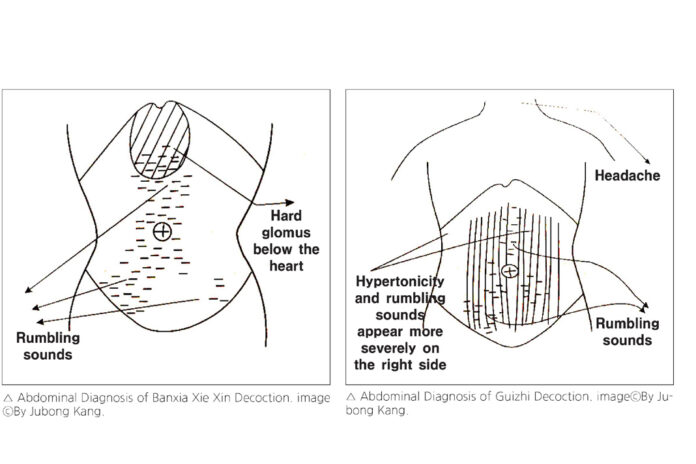The Dynamics of Shang Han Lun ⑪ Particulars-Part 1
By Jubong Kang, K.M.D.
Commentary on Banxia Xie Xin Decoction
Sign symptom of Banxia Xie Xin Decoction is ‘hard glomus below the heart’. Sometimes other symptoms come with ‘hard glomus below the heart’, such as retching, diarrhea, vexation, nausea, or anxiety. When ‘hard glomus below the heart’ is confirmed by palpation, then this formula can treat other symptoms of this sickness.
These symptoms can be differentiated in terms of disease such as: gastritis, gastric ulcer, esophagitis, stomatitis, diarrhea, duodenitis, duodenal ulcer, and can be treated by Banxia Xie Xin Decoction, when ‘hard glomus below the heart’ is felt by palpation.
Ingredients of this decoction are Banxia, Renshen, Huangjin, Huangkian, Gancao, Ganjiang and Dazao. Especially Banxia and Ganjiang, these herbs disperse stagnated water in the stomach and intense. Huangjin and Huanglian cure the inflammation of the stomach, the duodenum or the intestines.
Here, phlegm is water and inflammation is fire. Water and fire cannot be associated harmoniously in the region below the heart. Water became phlegm in the stomach and fire became inflammation of the inner wall of the stomach.
Banxia is like mild Mahuang which expands the bronchi mildly to increase the volume of the air being absorbed into the lungs, so as to increase oxygen combustion, which then supplies much more heat to help disperse water, i.e., phlegm in the stomach. Gangiang has property of pungent and hot and it stimulates the organs of medium burner. Banxia and shengijiang disperse water and restore the intestines digestive function.
Huangjin and Huanglian make the heart and brain less active bitter taste and cold property, thus keeping the stomach from overheating. Their other function is to directly clear heat and drain the fire of the digestive organs. Functioning like an anti-inflammatory agent to clear the fire in the stomach.
If a patient has a ‘hard glomus below the heart’ with rumbling sound, a pale and not reddish complexion, cold hands and feet, weak and slow pulse, and weak or no elasticity of abnominal muscles, then Li Zhong Decoction(Composed of Renshen, Baizhu, Ganjiang, Ganchao) has to be given.
If a patient has a sign symptom – ‘hard glomus below the heart’ – with reddish complexion, moderate pulse, elastic abdominal muscles and no runbling sound in the abdomen then Huanglian Huangjin Xie Xin Decoction(Composed of Huangglian, Huangjin) shoud be given.
And if these two symptoms above are combined then will treat it. Because Banxia Xie Xin Decoction is made out of Huanglian Huangjin Xie Xin Decoction and Li Zhong Decoction.
<2> Hypertonicity of the Abdominal Muscles (腹直筋攣急)
Herbs: Shaoyao (芍藥)
Ex. Formulas: Shaoyaogancao Decoction (芍薬甘草湯), Guizhi Decoction (桂枝湯)
Sentence (1)
If a counterflow patient recovers and the feet become warm, one can use Shaoyaogancao Decoction and then the feet will then be able to stretch (『San Han Lun』 Line 29, p. 187, PPV).
Sentence (2)
Guizhi Decoction is basically for resolving the flesh, if the person’s pulse is tight and floating and there is heat effusion and sweating is absent, it cannot be given. One needs always to be aware of this, so as not to cause error (ibid. Line 16B, p.75 PPV)
Commentary
The underline sentence, Guizhi Decoction is basically resolving the flesh, means that Guizhi Decoction has efficacy to treat flesh pain, which can be treated by the functions of warming and relaxation of Guizhi Decoction. Warming efficiency comes from Guizhi, relaxing efficiency comes from Shaoyao with the assistance of other herbs in Guizhi Decoction.
In practice, when we meet a patient whose illness could be recovered by Guizhi Decoction, sign symptom of Shaoyao is generally clear; therefore abdominal hypertonicity is used as a sign symptom of Guizhi Decoction.
The functions of Guizhi belongs to yang property which is more mobile and sign synptoms of Guizhi which are headache, scant urination or counterflow to the chest fullness; But the functions of Shaoyao belongs to yin property which is less mobile. Therefore it is easier to look for abdominal hypertonicity through Shayao.
In other words, hypertonicity is not only sigh symptom of Shaoyao but also sign symptom of Guizhi Decoction and this sign symptom-hypertonicity is important to decide whether one of Guizhi family decoction is adequate or not for a patient.
In Practice when we diagnose a patient who has sign symptoms of Guizhi Decoction, abdominal hypertonicity predominates on the right side of the abdomen rather than on the left side of it.
Because in the intestines, the gas and water is stagnated at the right side below the umbilicus where the large intestine and the small intestine both meet.
A more detailed interpretation on Guizhi Decoction is written in next edition.

































